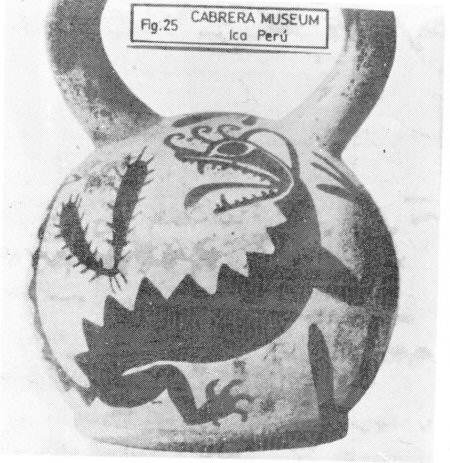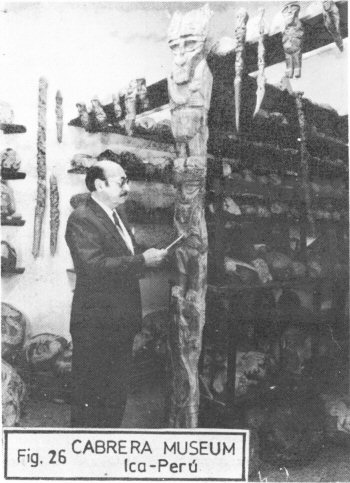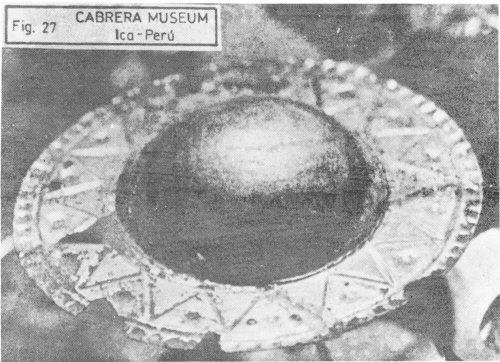(this material is an excerpt from the book
"The Message of the Stones", by Dr. Javier Cabrera)
(EXCERPT #3A)
WHY STONE WAS USED
The conventional wisdom that man as an intelligent, thinking being only appeared
250,000 years ago leads inevitably to the mistaken notion that before this date, all
humanoid or humanlike beings were primitive, pre-human, incapable of intellectuality. It
should not surprise, then, that one objection to the contention that in a very remote past
a highly advanced humanity existed which recorded its messages for posterity on stone is
this: if the civilization was so advanced, why did it leave its mark in such a common,
primitive material as stone, rather than in some other medium more appropriate to the
society's technological achievements? Modern humanity, after all, threatened by nuclear
holocaust, is trying to conserve the most important scientific and technological knowledge
on microfilms placed in vacuum tubes which are then buried underground and covered with a
layer of concrete. It is on the surface a persuasive objection, since the linking of
primitive beings and stone carvings, used to record daily life and to pass time, is strong
in the popular imagination.
But this linking, and therefore the objection itself, are not justified. The scientific
and technological achievements of the people whose historical documents are the
gliptoliths flowed from the constant application of knowledge to the world around them.
Their intention was not to leave documents to glorify themselves, but to leave a series of
guideposts for future humanity, to show those who would come after them the ways that man
can dominate his environment, and to warn that any departure from the pursuit of knowledge
could cause regression to the level of animals, a level which could mean the extinction of
the human race. If we consider the information contained in some gliptoliths regarding
situations in the remote past which endangered human genus (see Chapter Six), the purposes
behind the leaving of testimonials become more meaningful: the way in which man can avoid
regression to the animal state and avoid extinction is through constant application of
knowledge. The question for gliptolithic man became how to ensure the survival of these
documents in a future they could not predict. Without spurning the use of other materials
(metal, ceramic, wood, textiles, lithic architecture, etc., as we will see), gliptolithic
man preferred to use stone. Stone had several advantages. First, it was abundant
throughout the world, and therefore would not the likely to be used as a commodity in
commerce. Second, stone would not run the risk of being oxidized like metal and would
better resist the passage of time with engravings intact. Though they had dominated their
environment, they knew it was likely that future men would not know how to control
geological upheavals that might destroy the stones. For this reason, and also to protect
the stones from the effects of nature (atmospheric gases, rain, heat, cold, radiation,
etc.) they decided to protect them in excavated deposits in the most stable regions of the
planet. And they took other precautions: they did not modify the nature shaped of the
stone, so that it retained its resistance; and they buried the stones in sand so they
would not rub up against each other. It is thus that after these remote past, the engraved
stones are beautifully preserved.
OTHER MATERIALS WITH GLIPTOLITHIC WRITING
If we compare the designs on the
gliptoliths with those on other ancient objects of porcelain, ceramic, wood, and
cloth, scattered throughout the world, there is no doubt that gliptolithic nan
also used these materials to leave his messages. There are figures representing
fabulous animals which closely resemble many of those the paleontologists tell
as lived in the remote past, such as the dragons on Chinese porcelain, a
mythical animal but at the same time quite like the pterodactyl (winged
dinosaur). Another example is the figure of a stegasaurus on a ceramic found in
a tomb pertaining to the Pachacanac culture (a Pre-Incaic society) to the south
of
Lima
(Fig. 25). Similarly, we have the carved wood objects found in the desert to the
south of Ocucaje, lea, in which various prehistoric animals are depicted, one of
which shows dinosaurs (Fig. 26) as well as human figures. In others the figures
and designs reveal aspects of the scientific and technological achievements of
gliptolithic man, as for example, the symbolic representation of the technology
of space flight in many ceramics found in tombs from the Nasca culture (Pre-Incaic)
in the department of Ica (see illustrations in Chapter 9); also the symbolic
representations made in numerous Paracas cloths (Pre-Incaic culture) in the
department of Ica, which reveal a profound understanding of human microphysical
biology (see Chapter Seven, figure of Paracas cloth). In one Mochica (Pre-Incaic)
ceramic we can see the different phases through which an animal passed before it
was fully developed. There is no doubt that the animal in question is the
stegasaurus and that the phases are metamorphic phases. This further documents
that man coexisted with the dinosaur, that the latter was not hatched fully
developed (unlike paleontology teaches), and that man was a being so far evolved
that the possessed knowledge of biology (see figure previous page).

FIGURE 25: Ceramic with figure of
stegasaurus. The ceramic was found to the south of the city of Lima in a
Pachacamac (Pre-Incaic) tomb.
For this reason archeologists attribute the figure to the imagination of the
Pachacamac people, but it belongs in fact to the gliptolithic culture.

FIGURE 26: One of the many wood
objects that come from the south of Ocucaje, Ica.
This one reveals an aspect of the reproductive cycle of the dinosaur, knowledge
possessed by gliptolithic man.
I also think that gliptolithic man
left messages in sheets of metal resistant to time, such as gold and silver. The
unusual sheets of gold found in
Ecuador
whose designs resemble those the gliptoliths, provide evidence for
this hypothesis. These sheets form part of the collection
of
Father Carlo Crespi, and are housed in the Church of
Maria Auxiliadora, in Cuenca, Ecuador (Fig.
27).The
sheets
have not been dated. It is possible that gliptolithic humanity
knowing that man might have to avoid the end of his
existence by reverting to an animal state in which the instinct of egoism would
flourish, may have feared that man would then care less about figures and
symbols than about the material in which the
figures and symbols appeared. It is also possible that sheets of some unknown
material may have been used, but the same fear about the acceptance
of the messages would have prevailed. I think that gliptolithic man thought to
counteract the acquisitive instinct of future men by inscribing messages not on utilitarian
objects but on objects of beauty, as if they were adornments or decorations, so
that man would be more likely to value them and conserve them, and they could
one day be interpreted and understood for what they are. Thus
gliptolithic humanity engraved messages on
different types of silver ware, tools, and a variety of objects, preferably
of gold and silver, whose shape and designs even today are the subject of
ingenious and sometimes arbitrary interpretations.
Such is true in the case of the well-known turns of gold with
incrustations of precious stones, and the
tumis made from a very durable material called champi
(a
combination of gold, silver and copper, although the
bonding technique is unknown), found in Inca
and Pre-Inca tombs.

FIGURE 27: One of the unusual
sheets of gold found in Ecuador, whose origin has not been determined by
archeologists.
It was made by gliptolithic humanity and is today part of a collection which
Father Carlo Crespi keeps in the
Church of Maria Auxiliadora in Cuenca, Ecuador. Photo published in The Gold of
the Gods by Erich von Daniken.
Archeologists insist that these tumis were made by Inca or Pre-Inca men and they
think that they were used in ceremonial rites and as surgical instruments. But
the gold tumis with precious stones and the
tumis made of charapi were made by gliptolithic humanity, and the designs are
nothing but symbols amenable to deciphering (see Chapter
Five).
BACK TO EXCERPT INDEX